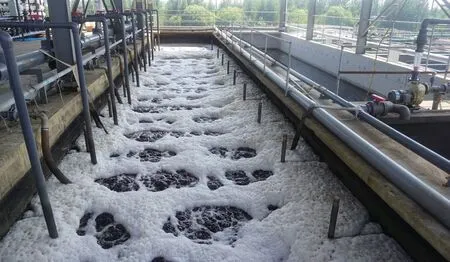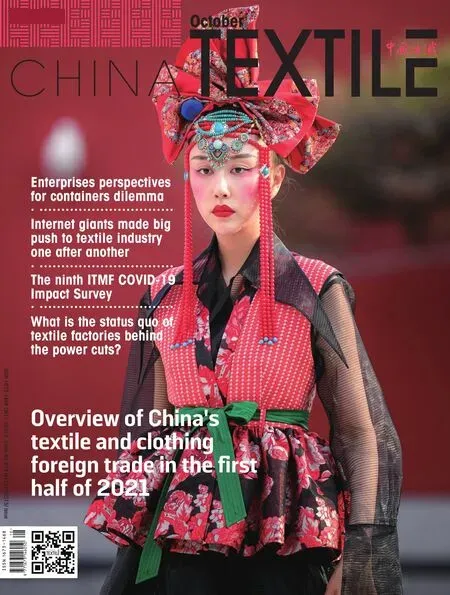Energy consumption contorl push enterprises accelerate intelligent transformation in turn
Edited by Zhong Mengxia

The "dual control of energy consumption" refers to the control of energy intensity and total energy consumption. It aims to meet the requirements of ecological progress, promote energy conservation and consumption reduction, and promote high-quality development. Thee policy of "dual control of energy consumption" began during the 11th Five-Year Plan period. At that time, with the rapid development of national economy and the rapid growth of energy consumption, the contradiction of resource constraint became more prominent.
The National Development and Reform Commission (NDRC) held a press conference in October last year, saying that from 2016 to 2019, China's energy consumption per unit of GDP decreased by 13.2 percent, saving about 650 million tons of standard coal, equivalent to reducing carbon dioxide emissions by about 1.4 billion tons. As China's economy enters a new normal, the focus of "dual control of energy consumption" has shifted from controlling total energy consumption to controlling energy consumption intensity.
On September 20, a power outage notice in Shaoxing Keqiao caused a huge response in the industry, 161 dyeing and printing and chemical fiber enterprises were involved, which may lead to a rise in dyeing fees and a large number of orders cannot be delivered on time. Energy intensity in Qinghai, Ningxia, Guangxi, Guangdong, Fujian, Xinjiang, Yunnan, Shaanxi and Jiangsu rose in the first half of the year compared with the same period last year.
Under the current servere situation of energy conservation, in order to further promote carbon peak and carbon neutral goals, all places across the country strictly implement the double control of energy consumption policy. Thee National Development and Reform Commission (NDRC) said local governments should be highly alert to the severe energy-saving situation in the first half of the year and take effective measures to ensure that the annual targets for controlling energy consumption, especially reducing energy intensity.
Jiangsu Nantong toke the lead to implement “dual control of energy consumption” policy
Since September 22, many listed companies issued responses to the national dual control of energy consumption policy, production lines temporarily suspended. From the release of limited production, halt production announcement, there are many enterprises with power outage and limited production in Yangtze River Delta area.
“Dual control of energy consumption” policy involves chemical fiber manufacturing, cotton spinning, wool spinning, yarn-dyed, non-woven, clothing, home textile and other industries. Nantong textile industry occupies an important position in Jiangsu. As a large textile province, a concentration area of upstream weaving links, Rudong county, Jiangsu, became the first local area to implement the dual control of energy consumption policy.
Under the supervision of Jiangsu Energy Conservation Supervision Center, a large number of weaving enterprises in Nantong, Jiangsu province, a large number of air jet and rapier loom shutdown. Officials in Nantong Rudong said that in order to avoid overwaste energy, Jiangsu province take energy consumption control as priority in September, and carry out long-term environmental assessment of key enterprises, so as to manage the budget of energy use of enterprises. Thee dual control measure was planned by county, and was carried out by town (street) by managing enterprise list and quota. In this process, they will pay attention to communication with enterprises, according to the actual order situation of enterprises and energy efficiency to promote electricity consumption.
“if there are some urgent orders have to be completed recently, local factories are allowed to complete the orders first.” Relative officials stressed that they will not just carry out this policy directly without caring about feelings of enterprises, and try to repect what they expect. Theis policy is not making all machines turn off, but the choice after communication between enterprises and government. Not only Jiangsu, currently, all parts of country have issued dual control policy.
Zhejiang high energy waste procedure moving out
In the 14th Five-Year Plan of Energy Saving, Consumption Reduction and Optimal Allocation of Energy Resources issued by Zhejiang Province, it is required to strengthen the structural adjustment of key energy-using areas. Ningbo and Zhoushan should strictly control the capacity scale of petrochemical, steel and chemical industries, promote the relocation of high-energy-consuming processes, and relieve the high dependence on fossil energy. Shaoxing, Huzhou, Jiaxing and Wenzhou should strictly control the manufacturing capacity of textile dyeing and printing, chemical fiber and plastic products, adopt advanced production technologies, raise the proportion of high-value-added products, and significantly raise energy efficiency per unit of value-added. We will encourage the textile dyeing and printing, chemical fiber, paper making, rubber and plastic products, electroplating and other industries to close down production capacity, step up efforts to eliminate backward and excess production capacity, and complete the clean-up of enterprises that are "scattered and nonstandard".
At the same time, Zhejiang is also speeding up the high-quality development of textile dyeing and printing enterprises and reducing environmental pollution through intelligent transformation. Annual output of 1.4 million tons of functional fiber intelligent production line construction project from Shaoxing Keqiao Hengming Chemical Fiber Co., Ltd. was in Shaoxing intelligent transformation key project plan (the first batch) list. Thee plan would seize the digital reform opportunity, through the application of large data, cloud computing, Internet of things, equipment monitoring technology, intelligent industrial robot such as digital technology and system integration, introduce the key technology and equipment, specialized intelligent equipment to implement intelligent production line technological transformation, realize the traditional manufacturing methods to change the way of intelligent manufacturing.
Theere are 17 textile, weaving and dyeing projects in Keqiao District, includes Zhejiang Baoren Hezhong Science and Technology Co., Ltd. with a total investment of 250 million yuan and an annual output of 15,000 tons of medical spunbonded non-woven fabric construction project, Shaoxing Zhiren Dyeing and Printing Co., Ltd., with a total investment of 200 million yuan, has an annual output of 170 million meters of woven dyeing and printing, knitting dyeing 21,000 tons of high-grade dyeing and printing fabric upgrading and technological transformation project, Zhejiang Shengxing Dyeing and Finishing Co., LTD., with a total investment of 100 million yuan, high-grade dyeing and printing fabric upgrading and technological transformation project.
The aim of dual control of energy consumption is highquality development
Meng Wei, spokesperson for the National Development and Reform Commission (NDRC), said at a press conference that since the beginning of this year, all regions and departments have actively promoted carbon neutral and achieved certain results. However, in some places, industries and enterprises, the focus of work is not proper. In some places, the implementation of dual control on energy consumption has not been effective. Some industries rely on a single technology to solve their problems once and for all. Some organizations are enthusiastic about labeling and branding.
In addition to the weak foundation of energy conservation and emission reduction, Meng Wei also proposed that some industries and enterprises are eager to "grab the first prize" and put forward goals beyond the stage of development. Some places shut down energyintensive projects altogether. Some financial institutions suddenly cut off loans for projects such as coal and electricity. Some have shouted loud slogans but failed to keep up with their actions. Theese phenomena run counter to the original intention and requirements of carbon peak and carbon neutral, which must be resolutely corrected.
In fact, the dual control goal corresponds to higher quality development. After combing the economic operation data of Nantong, Zhenjiang, Yancheng and other cities in the first half of the year, the relevant media found that the economic operation of these cities showed a recovery trend of growth in the first half of the year, and the total social electricity consumption and industrial electricity consumption also increased by more than 20%.
Thee person in charge of a garment factory in Nantong said that if electricity consumption is reduced, the factory will use stricter management and better arrangement to improve efficiency, thus reducing the working time. "For example, we usually work for 10 hours a day, then we reduce the working time by 1 to 1.5 hours." He said the impact on factory production would not be too great, as long as the working hours are not allowed to be cut back every day. Theere is an incentive for factories to improve efficiency under dual control targets. Garment factories are now solar powered. About 20 percent of the plant's annual electricity consumption comes from its own solar power, he said.
Jiangsu Suqian city leaders in the inspection of new material enterprises said, hope that enterprises look at the long-term development, with energy consumption dual control as an opportunity to accelerate the implementation of green transformation and high-end upgrading enterprises.
Opportunity in difficulty
Many factories have been caught off guard by the power rationing policies of major industrial provinces just before the crucial moment of annual results. Under the pressure of energy consumption policy, how to deal with the strategy is the biggest challenge facing enterprises at the present stage.
From the current situation, most of the domestic manufacturing plants have suffered a major blow due to the reduction of production capacity caused by power rationing, but from the perspective of market demand, not only will it not fall, and even there is a great possibility that it will continue to rise. Theerefore, the focus of enterprise consideration can not only be on expand source, grasp the profit space, or will usher rapid development.
Due to the decline of factory capacity, the extension of factory delivery time will lead to greater inventory pressure, so it is difficult for most enterprises to find a high-quality supply chain in a short time. In order to avoid the loss of important customers, we should give priority to the production capacity to old customers, stabilize them and minimize the loss as far as possible. At the same time, enterprises should adjust storage management according to the national policy regulation, and then make procurement preparations in advance according to the following sales targets.
In addition, some industry analysts believe that in the short term, the imbalance of supply may lead to price increases, driving performance flexibility. Theerefore, unsalable products have the opportunity to clear goods, hot-selling products to make profits, improve product unit price, do a good job in product services, enterprises.

- China Textile的其它文章
- Overview of China's textile and clothing foreign trade in the first half of 2021
- Pandemic prevention materials exported fell rapidly
- Ministry of Commerce: China's foreign trade may encounter huge pressure next year
- Enterprises perspectives for containers dilemma
- Internet giants made big push to textile industry one after another
- Changes in China’s sportswear industry

